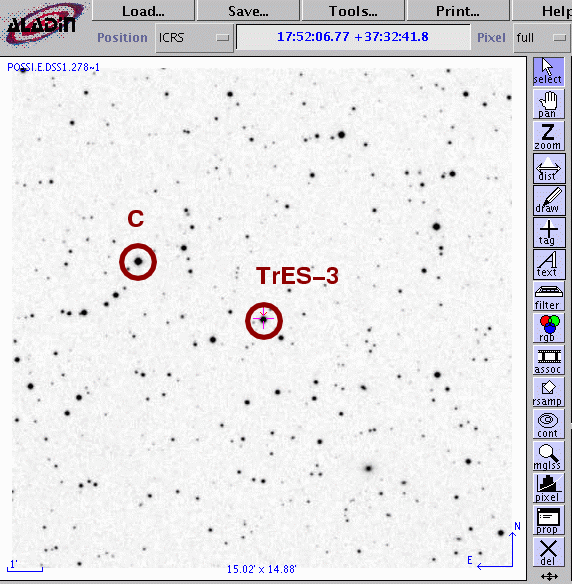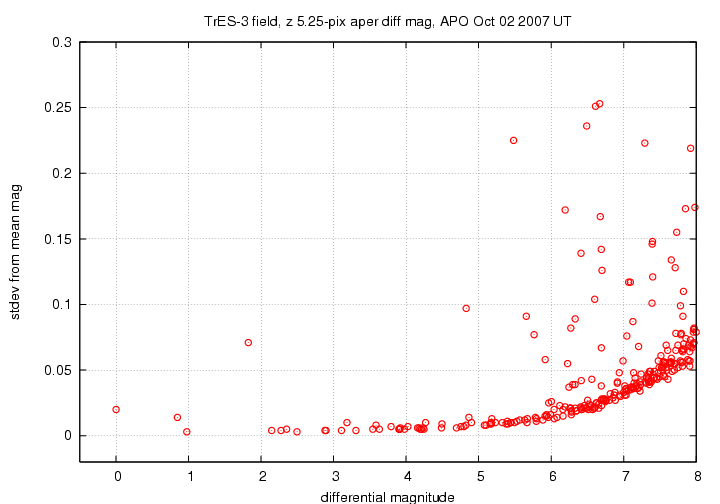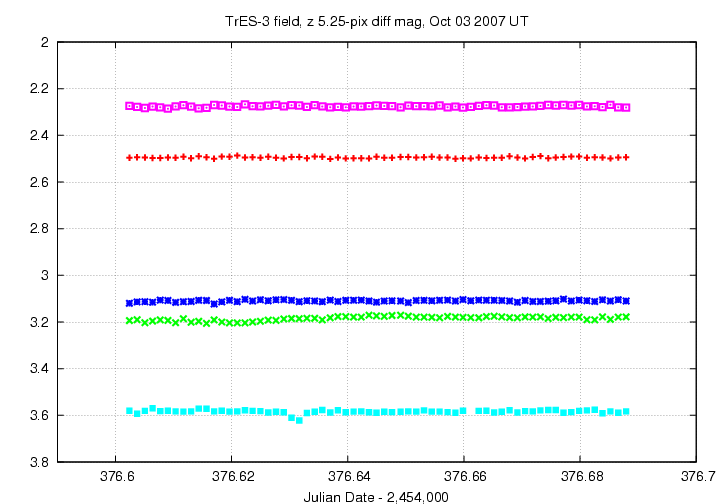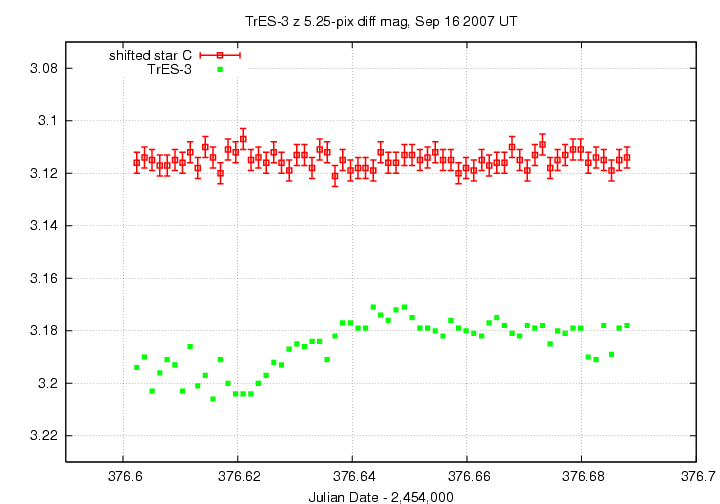
On the night of UT Oct 03, 2007, the SDSS Photometric Telescope ("PT" for short) took a series of exposures of the field around TrES-3 . The series included only the middle and end of the transit, ending some time after egress; it missed the ingress.
Notes from the night
This is a chart of the field. TrES-3 is the bright star indicated by the crosshairs. I have marked one bright star nearby which will appear (together with other stars not on this chart) later in graphs.

The star marked "C" has Tycho-2 magnitudes of Bt=12.95, Vt=11.83. The host star of TrES-2 itself has a magnitude V=12.40, according to TrES-3: A Nearby, Massive, Transiting Hot Jupiter in a 31-Hour Orbit.
Following the procedures outlined by Kent Honeycutt's article on inhomogeneous ensemble photometry, I used all stars available in each image to define a reference frame, and measured each star against this frame. You can find the software package used to do the ensemble photometry online; it's free!
Below is a graph of the scatter in differential magnitude versus magnitude in the ensemble solution. I marked all stars brighter than differential magnitude 2.0 as "saturated," so that they would not influence the ensemble solution.

TrES-3 is the star at differential mag 3.1; note its slightly elevated scatter. The "noise floor" in these measurements is about 0.004 mag -- very nice!
Below are the light curves for the target (green symbols) and four comparison stars in the field.

You can see that TrES-3 is dimmer in the early stages of this run. The transit is obvious when we zoom in: in this closeup, I have shifted the data for star C to move them closer in magnitude to the target.

An ephemeris grabbed from transitsearch.org predicts for this night
----------------------------------------------------------------------------------------
Begin Transit Window PREDICTED CENTRAL TRANSIT End Transit Window
All Times UT
HJD Year M D H M
2454376.58 2007 10 3 1 48 2454376.61 2007 10 3 2 43 2454376.65 2007 10 3 3 39
----------------------------------------------------------------------------------------
The egress end of UT 2007 Oct 03 03:39:00 corresponds to JD 2,454,376.652. That seems a bit later than the light curve above would suggest -- the light curve indicates egress ends at about 376.640, some 17 minutes earlier than the ephemeris.
Now, note that on an earlier night , PT observations suggested that the ingress began later than predicted by the ephemeris. On this night, we see the transit end earlier than predicted.
This suggests that the ephemeris is based on a transit duration which is longer than the actual transit.
However, don't jump to conclusions: we did not observe both ends of a transit on a single night; and the ingress observations were made in the i'-band, while these egress measurements were made in the z'-band. The difference in filter could make a small difference in transit properties.
You can grab the measurements for your own analysis. Below is a table with three flavors of time, plus the differential magnitude of TrES-3 and an estimate of the uncertainty in each measurement. I show the first few lines of the file to give you an idea of its format.
# Measurements of TrES-3 made with APO PT, Oct 3, 2007 UT. # Each exposure 30 seconds long in SDSS z-band; # Tabulated times are midexposure and accurate only to +/- 1 second (??). # 'mag' is a differential magnitude based on ensemble photometry # using a circular aperture of radius 5.25 arcseconds. # # UT day JD-2,450,000 HJD-2,450,000 mag uncert Oct03.60239 4376.60239 4376.60178 3.194 0.005 Oct03.60372 4376.60372 4376.60311 3.190 0.005 Oct03.60506 4376.60506 4376.60445 3.203 0.005Warning: the times in this datafile have a small systematic error. I assumed the FITS header time was the shutter open time, so added half the exposure time to it. The FITS header time is instead roughly the shutter CLOSING time. My calculated times are therefore later than correct by about the duration of one exposure.
Last modified 11/07/2007 by MWR.